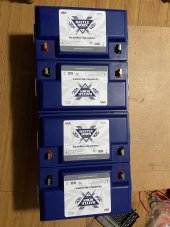2000 watt inverter / 24 volt system * .85 inverter efficiency * 1.25 OCP fudge factor = 88.5 amps. OCP protection of 120 amps is perhaps a bit high, but not bad.
The 1.25 OCP (Over Current Protection) fudge factor is to get the fuse or breaker 25% over what the expected amperage on the wire is, without causing nuisance trips. If we ignored that, you might put in a 70 amp breaker and every time the inverter hit 2,000 watts, the breaker could trip.
The 1.25 OCP (Over Current Protection) fudge factor is to get the fuse or breaker 25% over what the expected amperage on the wire is, without causing nuisance trips. If we ignored that, you might put in a 70 amp breaker and every time the inverter hit 2,000 watts, the breaker could trip.




